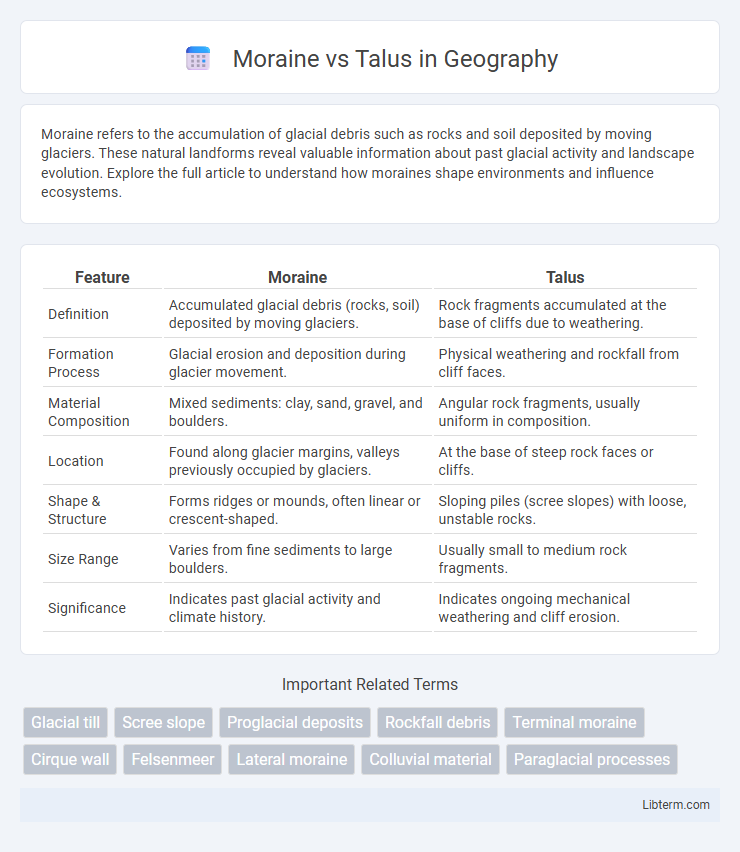Moraine refers to the accumulation of glacial debris such as rocks and soil deposited by moving glaciers. These natural landforms reveal valuable information about past glacial activity and landscape evolution. Explore the full article to understand how moraines shape environments and influence ecosystems.
Table of Comparison
| Feature | Moraine | Talus |
|---|---|---|
| Definition | Accumulated glacial debris (rocks, soil) deposited by moving glaciers. | Rock fragments accumulated at the base of cliffs due to weathering. |
| Formation Process | Glacial erosion and deposition during glacier movement. | Physical weathering and rockfall from cliff faces. |
| Material Composition | Mixed sediments: clay, sand, gravel, and boulders. | Angular rock fragments, usually uniform in composition. |
| Location | Found along glacier margins, valleys previously occupied by glaciers. | At the base of steep rock faces or cliffs. |
| Shape & Structure | Forms ridges or mounds, often linear or crescent-shaped. | Sloping piles (scree slopes) with loose, unstable rocks. |
| Size Range | Varies from fine sediments to large boulders. | Usually small to medium rock fragments. |
| Significance | Indicates past glacial activity and climate history. | Indicates ongoing mechanical weathering and cliff erosion. |
Introduction to Moraine and Talus
Moraine and talus are both geological formations composed of rock debris, but they differ in origin and appearance. Moraines are accumulations of glacial debris such as soil and rock left behind by moving glaciers, often forming ridges or mounds. Talus consists of angular rock fragments that accumulate at the base of cliffs or steep slopes due to physical weathering and rockfall processes.
Defining Moraine: Formation and Characteristics
Moraine is a glacially formed accumulation of unconsolidated debris, including soil and rock, deposited directly by glacier ice or meltwater. These landforms develop as glaciers advance and retreat, leaving behind distinctive ridges or mounds composed of till. Moraines are characterized by a heterogeneous mixture of sizes and shapes of debris, ranging from fine sediments to large boulders, which differs from the more sorted, angular rock fragments typically found in talus deposits.
Understanding Talus: Formation and Features
Talus forms from the accumulation of rock fragments that break off steep cliffs or slopes due to physical weathering processes like freeze-thaw cycles, resulting in a sloping pile of angular debris at the base of the source area. These deposits are typically unsorted and lack the fine sediments found in moraines, reflecting their origin from direct rockfall rather than glacial transport. Talus slopes exhibit distinct loose, unstable characteristics compared to the compacted, ice-mixed composition of moraines formed by glacial activity.
Geological Processes Behind Moraines
Moraines form from the accumulation of glacial debris, such as rocks and sediment, transported and deposited by moving glaciers. This geological process involves ice erosion and plucking, where glaciers erode the landscape and carry material along their path. In contrast, talus results primarily from physical weathering and rockfall, accumulating at the base of cliffs without glacier involvement.
Erosional and Depositional Mechanisms in Talus Formation
Talus forms primarily through the erosional mechanism of physical weathering, where freeze-thaw cycles and gravity-induced rockfall cause rock fragments to detach from cliffs and accumulate at the base. Unlike moraines, which are depositional landforms created by glacier ice transporting and depositing till, talus slopes are composed of angular, unsorted debris resulting from ongoing slope erosion. The depositional process in talus formation is continuous and localized, driven by gravitational transport without significant influence from glacial activity.
Key Differences Between Moraine and Talus
Moraine and talus are both geological formations composed of rock debris, but moraines are specifically formed by glacial activity, consisting of unsorted sediment deposited directly by a glacier, whereas talus refers to angular rock fragments accumulated at the base of cliffs or steep slopes mainly through physical weathering. Moraines typically exhibit layered, compacted material including clay, silt, sand, and boulders, while talus piles are characterized by loose, sharp-edged rocks without fine sediment. The key distinction lies in their formation processes and composition: moraines indicate past glacial movement and deformation, whereas talus reflects gravity-driven rockfall and mechanical breakdown.
Environmental Significance of Moraines
Moraines serve as crucial indicators of past glacial activity, shaping ecosystems by influencing soil composition and water flow patterns. They create diverse habitats that support unique plant and animal communities, enhancing biodiversity in glaciated regions. Unlike talus slopes formed primarily by mechanical weathering, moraines play a significant role in carbon storage and landscape evolution due to their organic-rich sediments.
Ecological Impact of Talus Slopes
Talus slopes provide unique ecological niches, supporting diverse flora and fauna adapted to the unstable, rocky environment. These slopes contribute to biodiversity by serving as critical habitats for specialized species, such as pikas and certain mosses, which play essential roles in their respective ecosystems. The porous nature of talus also influences local hydrology, affecting soil moisture and nutrient cycling crucial for surrounding vegetation.
Identification and Field Recognition Tips
Moraine is an accumulation of glacial debris such as rocks and soil, typically forming ridges or mounds along glacier edges, characterized by unsorted and angular materials. Talus consists of rock fragments that accumulate at the base of cliffs, usually showing more sorted, angular to subangular rocks created by freeze-thaw weathering. Identify moraine by its association with glacial landscapes and the presence of a mix of particle sizes, while talus is recognized by its location beneath steep rock faces and well-graded, blocky rock fragments.
Summary: Choosing Between Moraine and Talus
Moraine consists of glacially deposited rock debris, often forming ridges or mounds that indicate past glacier activity, while talus is a collection of angular rock fragments accumulated at the base of cliffs due to mechanical weathering. Selecting between moraine and talus depends on geological context and environmental conditions: moraine signals glacial influence and is key in paleoclimate studies, whereas talus reflects ongoing rockfall dynamics and slope stability. For geomorphological analysis, moraine provides insight into glacial processes, while talus offers data on erosion and rock mass movements.
Moraine Infographic

 libterm.com
libterm.com